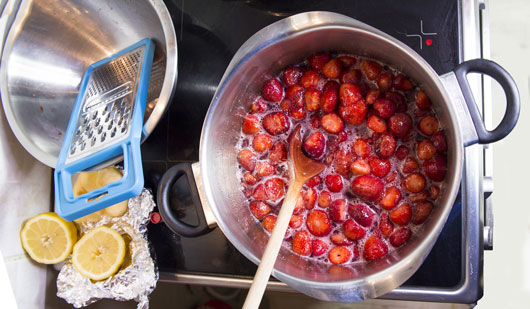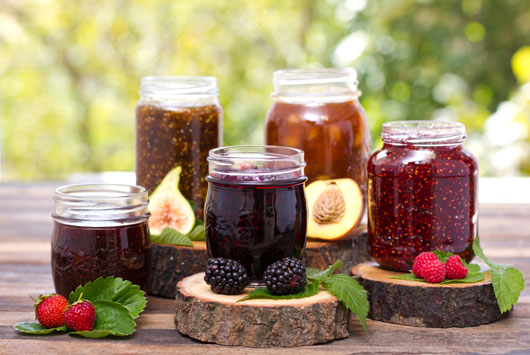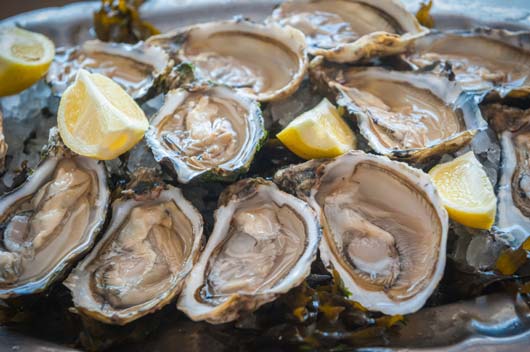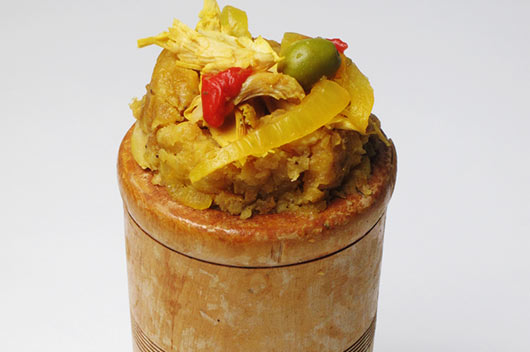
Jam is a fan favorite when it comes to breakfast foods, afternoon treats, desserts and everything in between. And making your own homemade jam, from fresh ingredients and a little bit of love, takes that treat to a whole other level of tasty. Before you shake your head and run to the grocery store to buy a packaged spread, hear us out. Making jam yourself is shockingly easy to do. Plus, it makes an amazing addition to any brunch party, it’s a great gift for your friend or neighbor who has everything, and you’ll get to preserve the flavors of summer for just a little bit longer, one spoonful at a time.
According to Mark Bittman in an article for the NY Times, homemade jam is special because it “actually reminds you of the fruit from which it’s made, rather than a pile of melted fruit-flavored sugar, as do most mass-produced jams.” So you get the best of both worlds—the flavor of the fresh, ripe, perfectly picked summer fruit, and the convenience and texture of a delicious spread.
So where do you start with homemade jam? First, you need to pick which fruit you want to use. Sure, you could stick to only one fruit (strawberry jam is a classic for a reason), or you could get a little fancy and mix and match different berries and fruits based on your mood. The priority is to pick fruits that are fresh, in season, and at their peak ripeness, but not overly ripe. According to Bon Appetit, “older fruit has lower acid and less pectin, which yields a runny, one-note jam that will bum out any piece of toast.”
Read Related: The Better Butter: 17 Unexpected Ways to Cook Using Peanut Butter

Next, you need to understand a little bit about how jam is made. It’s pretty simple, actually. Jam is the product when fruit is cooked with sugar to create a somewhat chunky textured puree (you should actually see some chunks of fruit). While the terms jelly and jam are often used interchangeably, jelly is the result when a jam is passed through a jelly bag, so it is thinner and smoother. Pectin, according to Bon Appetit, is “what causes jam and jelly to gel. [Pectin is] naturally occurring in lots of fruit, especially grapes, apples, cherries, and citrus; you can also buy it in powdered form.” Ideally you want a jam that has body and texture, but is soft enough that you can spread it.
As The Kitchn.com tells it, the main ingredients in most jams include fruit, sugar and lemon juice. “Lemon is used in jam to add acidic balance and pectin.” It also naturally balances out the sweetness of the fruit, so that there is a nice sweet to acid ratio. On the flip side, sugar adds sweetness, should you need an additional sweetening agent on top of the boiled fruit that you use. What’s great about homemade jam is that you can control the sweetness, as opposed to store-bough brands, which are often loaded with unnecessary sugar. Start by boiling your fruit of choice with the lemon juice and a small quantity of sugar, and then add to taste as needed.

According to Bon Appetit, when it comes to packaging, using canned jars is a classic and cute way to bottle up your goods. Start with sterilized jars (simply boil them for about 10 minutes), and ladle in the hot jam right out of the pot. For jams you plan to eat right away, all you need to do is let that jam cool. For jams you want to preserve and use later, screw on the lid, just make sure it’s not too tight so that if your jam expands the glass won’t crack. Next, using a jar lifter or tongs, carefully lower your jar into a pot of gently boiling water so that water covers your jar by about an inch or two. Let it simmer for 10-20 minutes, then carefully remove the jars and let them cool. After they are cool, test the lit to make sure the seal is closed and no air can get in or out. Once you’re done, those preserved jams can last for up to a year, which means you can enjoy your summer fruit any time of year, even during the first snowfall of the winter season.
Here are a few delicious and easy jam recipes to get you started. And remember, practice makes perfect, so you have our permission to make lots of jam and play around with the ingredients until you get it just right. We doubt your friends will complain if you ask them to taste your creations.

Spicy Tomato Jam
Not all jams have to be 100% sweet. This spicy tomato jam mixes tomatoes with lemon juice and zest, cinnamon, cumin, red pepper flakes, cloves and ginger.
Strawberry Jam
You can’t go wrong with this classic jam recipe and this recipe only takes about 10 minutes of cooking time, and then you just need to let your jam cool and thicken.
Honey and Thyme Blackberry Jam
This recipe has the standard fruit and sugar ingredients, but it also uses honey for natural sweetness and thyme for a complex, savory seasoning.
Plum Jam
You might not typically think of using plums for jam (berries and apricots are much more common), but plum jam is a perfect blend of sweet and tart, and it tastes like summer.
Photo 4 courtesy of Food Network.com










